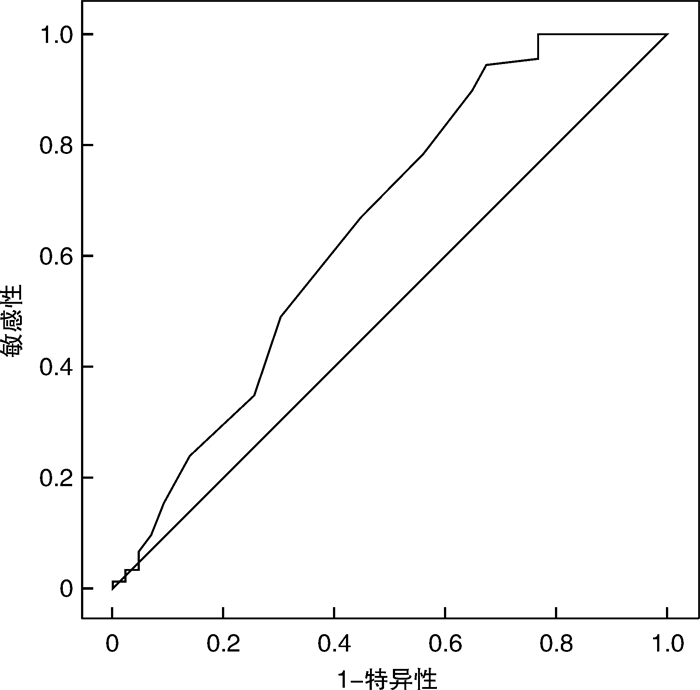Analysis of risk factors for re-operation due to postoperative haemorrhage following coblation-assisted tonsillectomy
-
摘要: 目的 探讨扁桃体低温等离子射频消融术后出血再手术的危险因素。方法 收集135例于2015年1月—2022年5月期间行扁桃体低温等离子射频消融术后出血患者的临床资料,根据是否再行手术治疗,将135例患者分为手术治疗组(43例)和保守治疗组(92例),对两组患者的临床资料进行对比分析。结果 单因素分析结果显示两组患者性别、年龄、术后静脉使用糖皮质激素、伴随糖尿病及高血压病方面比较差异无统计学意义(P>0.05),单因素及多因素分析结果显示两组患者在出血时间、检查有明确活动性出血点方面比较差异有统计学意义(P < 0.05)。结论 出血时间早、检查有明确活动性出血点是扁桃体低温等离子射频消融术后出血再手术的独立危险因素。
-
关键词:
- 低温等离子射频消融术 /
- 扁桃体切除术 /
- 出血 /
- 再手术
Abstract: Objective To investigate the risk factors for re-operation due to postoperative haemorrhage following coblation-assisted tonsillectomy.Methods The clinical data of 135 patients with haemorrhage after coblation-assisted tonsillectomy in our hospital from January 2015 to May 2022 were collected, According to the patients received reoperation after tonsillectomy or not, all patients were divided into the reoperation group (n=43) and non-reoperation group (n=92), clinical data were compared between the two groups.Results Univariate analysis showed that there was no significant difference in gender, age, postoperative intravenous glucocorticoid use, diabetes and hypertension between the two groups(P>0.05), Univariate and multivariate factor analyses showed that early haemorrhage, obvious hemorrhage points were independent risk factors for re-operation due to postoperative haemorrhage(P < 0.05).Conclusion Early haemorrhage and obvious hemorrhage points are independent risk factors for re-operation due to postoperative haemorrhage following coblation-assisted tonsillectomy.-
Key words:
- low temperature plasma radiofrequency ablation /
- tonsillectomy /
- hemorrhage /
- reoperation
-

-
表 1 扁桃体低温等离子射频消融术后出血再手术相关危险因素的单因素分析
因素 手术治疗组
(n=43)保守治疗组
(n=92)P值 性别/例 0.083 男 31 52 女 12 40 年龄/[岁,M(Q1,Q3)] 18(10,33) 13(6,31) 0.201 出血时间/[d,M(Q1,Q3)] 7(4,10) 8(7,10) 0.004 有明确的活动性出血点/例 < 0.001 有 41 24 无 2 68 糖尿病/例 0.319 是 1 0 否 42 92 高血压病/例 1.000 是 1 3 否 42 89 糖皮质激素使用/例 0.076 是 9 9 否 34 83 表 2 扁桃体低温等离子射频消融术后出血再手术相关危险因素的多因素logistic回归分析
因素 回归系数(B) P值 Wald OR值 性别 0.725 0.198 1.659 2.065 年龄 -0.005 0.781 0.078 0.995 出血时间 -0.139 0.031 4.629 0.870 明确的活动性出血点 4.059 < 0.001 26.664 57.926 糖尿病 21.850 1.000 < 0.001 3086938731 高血压病 -0.965 0.509 0.436 0.381 糖皮质激素使用 -0.160 0.829 0.047 0.852 -
[1] Li J, Luo L, Chen W, et al. Application of Coblation Tonsillectomy with Inferior Pole Capsule Preservation in Pediatric Patients[J]. Laryngoscope, 2021, 131(5): 1157-1162. doi: 10.1002/lary.29089
[2] Faramarzi M, Shishegar M, Kazemi T, et al. The effect of applying amniotic membrane on post-tonsillectomy pain and bleeding[J]. Eur Arch Otorhinolaryngol, 2021, 278(2): 485-492. doi: 10.1007/s00405-020-06173-7
[3] 黎景佳, 陈伟雄, 张剑利, 等. 联合被膜内外低温等离子扁桃体切除术在减少儿童OSA术中和术后出血中的应用[J]. 临床耳鼻咽喉头颈外科杂志, 2020, 34(2): 131-135. https://www.cnki.com.cn/Article/CJFDTOTAL-LCEH202002008.htm
[4] 易星, 邓腾波. 扁桃体低温等离子融切术后出血的相关危险因素分析[J]. 临床耳鼻咽喉头颈外科杂志, 2019, 33(5): 407-410. doi: 10.13201/j.issn.1001-1781.2019.05.006
[5] 隋海晶, 肖水芳, 秦永, 等. 等离子射频辅助的悬雍垂腭咽成形术后出血的临床研究[J]. 中华耳鼻咽喉头颈外科杂志, 2010, 45(10): 830-834. doi: 10.3760/cma.j.issn.1673-0860.2010.10.011
[6] Kang KT, Chang IS, Tseng CC, et al. Impacts of disease severity on postoperative complications in children with sleep-disordered breathing[J]. Laryngoscope, 2017, 127(11): 2646-2652. doi: 10.1002/lary.26539
[7] Ordemann AG, Hartzog AJ, Seals SR, et al. Is weight a predictive risk factor of postoperative tonsillectomy bleed?[J]. Laryngoscope Investig Otolaryngol, 2018, 3(3): 238-243. doi: 10.1002/lio2.155
[8] Billings KR, Stake C, Arzu J, et al. Outcomes of a Postoperative Data-Extraction Questionnaire After Adenotonsillectomy in Children[J]. Laryngoscope, 2021, 131(11): E2821-E2826.
[9] Windsor AM, Soldatova L, Elden L. Endovascular Embolization for Control of Post-Tonsillectomy Hemorrhage[J]. Cureus, 2021, 13(2): e13217.
[10] 董飞林, 苏立众, 罗祖炎, 等. 扁桃体术后假性动脉瘤出血介入栓塞一例[J]. 中华耳鼻咽喉头颈外科杂志, 2020, 55(6): 620-622. doi: 10.3760/cma.j.cn115330-20191112-00684
[11] Choi KJ, Cheng T, Cobb MI, et al. Recurrent post-tonsillectomy bleeding due to an iatrogenic facial artery pseudoaneurysm[J]. Acta Otolaryngol Case Rep, 2017, 2(1): 103-106.
[12] Ronen O, Sela E, Degabli L. The effect of bleeding on children's haemodynamic indices: an analysis of previous post-tonsillectomy bleeding cases[J]. J Laryngol Otol, 2020, 134(5): 453-457. doi: 10.1017/S0022215120000328
[13] Gonçalves AI, Rato C, de Vilhena D, et al. Evaluation of post-tonsillectomy hemorrhage and assessment of risk factors[J]. Eur Arch Otorhinolaryngol, 2020, 277(11): 3095-3102. doi: 10.1007/s00405-020-06060-1
[14] Leader BA, Wiebracht ND, Meinzen-Derr J, et al. The impact of resident involvement on tonsillectomy outcomes and surgical time[J]. Laryngoscope, 2020, 130(10): 2481-2486. doi: 10.1002/lary.28427
[15] 杨钦泰, 邓慧仪, 王玮豪, 等. 难治性鼻出血隐匿出血部位的分布和治疗[J]. 中国耳鼻咽喉头颈外科, 2016, 23(10): 602-605. https://www.cnki.com.cn/Article/CJFDTOTAL-EBYT201610014.htm
[16] 田莉, 林镝. 儿童扁桃体切除术后继发性出血的危险因素分析[J]. 临床耳鼻咽喉头颈外科杂志, 2018, 32(23): 1813-1816. https://www.cnki.com.cn/Article/CJFDTOTAL-LCEH201823011.htm
[17] 王媛媛, 赵飞鹏, 罗剑, 等. 低温等离子扁桃体切除术后出血的临床讨论[J]. 中国中西医结合耳鼻咽喉科杂志, 2019, 27(1): 49-51. https://www.cnki.com.cn/Article/CJFDTOTAL-XYJH201901010.htm
[18] Hsueh WY, Hsu WC, Ko JY, et al. Population-based survey of inpatient pediatric tonsillectomy and postoperative hemorrhage in Taiwan, 1997-2012[J]. Int J Pediatr Otorhinolaryngol, 2018, 108: 55-62.
[19] Brigger MT, Cunningham MJ, Hartnick CJ. Dexamethasone administration and postoperative bleeding risk in children undergoing tonsillectomy[J]. Arch Otolaryngol Head Neck Surg, 2010, 136(8): 766-772.
[20] Noblitt BR, Siddiqui F, Iverson KC. Hemorrhage Rates in Pediatric Patients Receiving Postoperative Steroids After Tonsillectomy[J]. Clin Pediatr(Phila), 2021, 60(1): 20-24.
[21] Álvarez Palacios I, González-Orús álvarez-Morujo R, Alonso Martínez C. Postoperative Pain in Adult Tonsillectomy: Is There Any Difference Between the Technique?[J]. Indian J Otolaryngol Head Neck Surg, 2017, 69(2): 187-193.
-





 下载:
下载: